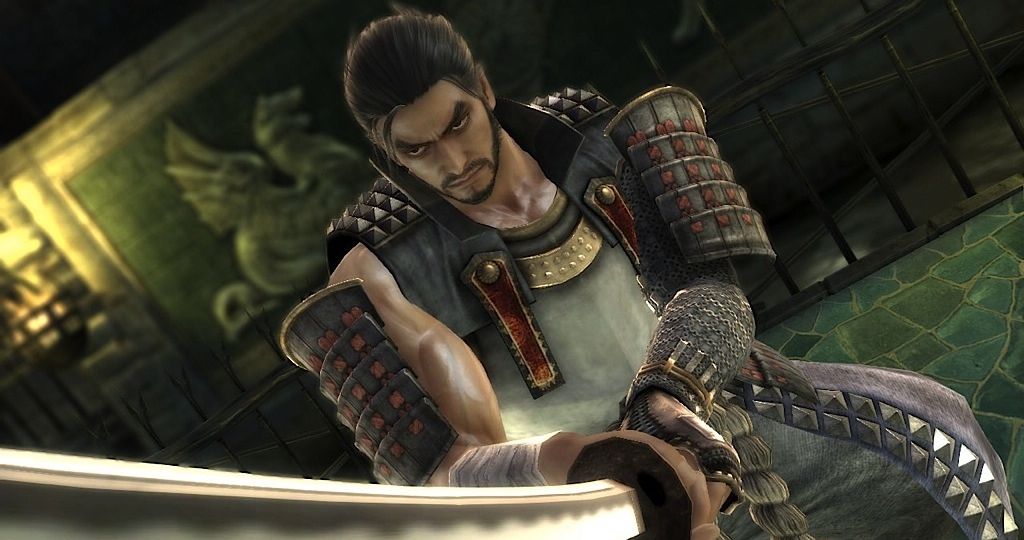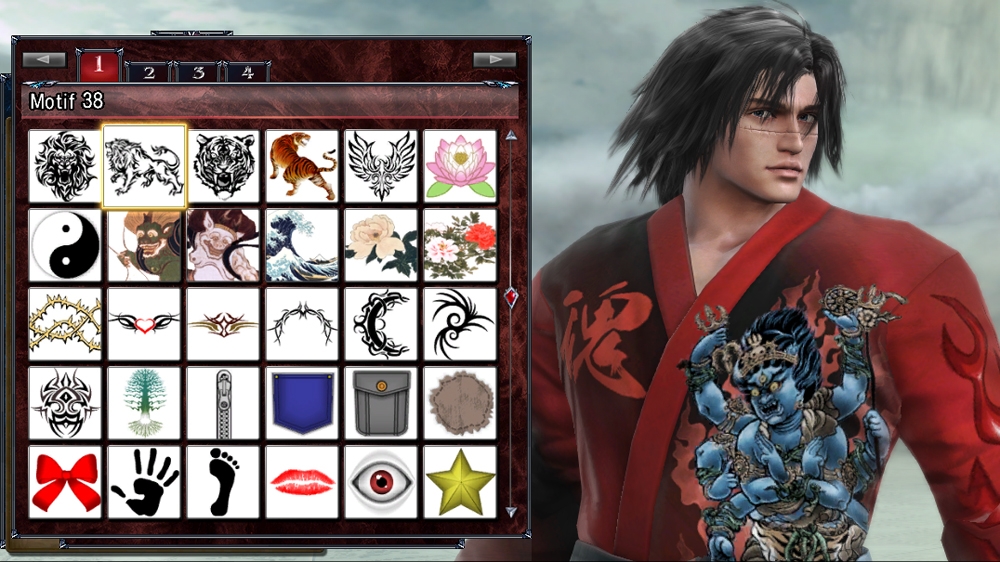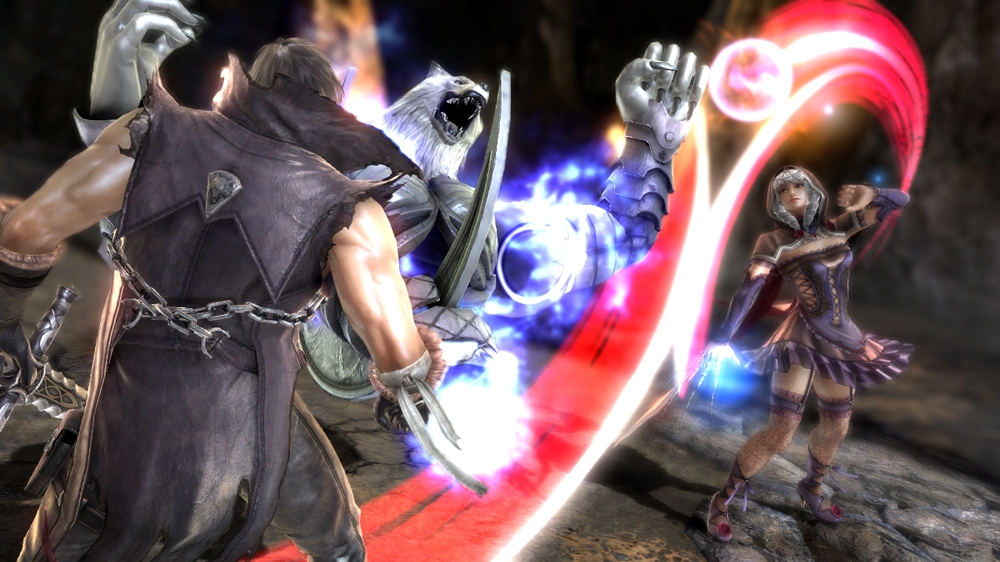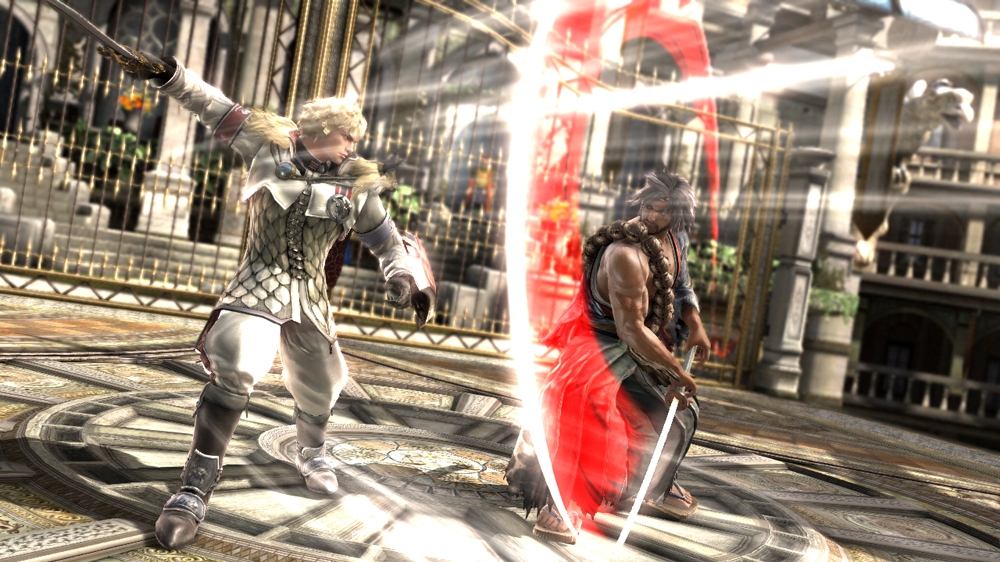
It’s been three and a half years since Soul Calibur IV was released, and since then fighting fanatics have witnessed the resurrection of Street Fighter, Marvel vs Capcom, and Mortal Kombat—three behemoths that dominate the genre here in the United States. As terrifying as that may sound for the folks at Project Soul, they’ve returned in 2012 with their most impressive offering to date; Soul Calibur V boasts the best online play I’ve ever experienced in a fighting game, a roster full of new faces, and a perfect balance of combat tweaks and additions that feel new and exciting, yet minimal enough to preserve the sense of nostalgia that has transcended the series since Soul Edge.
Plot and Characters
The opening scene of Soul Calibur V feels familiar as soon as it begins; Nightmare and Siegfried are locked in their eternal battle that has spanned four games without resolution. Light refracts brilliantly through the gem inlaid in the hilt of Siegfried’s Soul Calibur while Nightmare’s Soul Edge is looking just as meaty as ever, grinning a mouthful of fangs as it collides headfirst with its rival. Elsewhere, Patroklos—the son of Sophitia—embarks on a misguided quest to rescue his sister Pyrrha from Tira.
And yeah, their names totally rhyme.
Story mode relies on Soul Calibur’s signature inexplicable flip-flop between animated cutscenes and narrated storyboards to convey why you’re fighting, but even after paying close attention I’m not entirely sure what happened. I will say this though: throughout the course of the story (which lasts about three hours without skipping any cutscenes), you will travel through time once or twice, and wield a weapon that is also a goddess. It’s like Bionic Commando’s wife arm ridiculousness all over again, and it’s totally oedipal; I’m stoked on it. Although slightly convoluted, the story is definitely enjoyable—I hope you like fighting as Sophitia and Cassandra though, because they’re essentially your only options, save for one or two levels where the perspective changes.
Since Soul Calibur V is set some twenty-odd years after the previous entry in the series, a few of the veterans were actually scrapped in favor of more youthful fighters who practice the same techniques as their predecessors. Kilik, Xianghua, Cassandra and Sophitia, and Taki have been replaced with newcomers, while Yung Sung, Sueng Mina, Zasalamel, Amy, Setsuka, and Talim are nowhere to be found at the start of the game. Don’t get too worried though; after playing through the story and unlocking a few characters, you’ll start to fill those empty slots on the roster screen with familiar faces. All of the new characters are enjoyable in their own rights, and the new fighting styles Project Soul has introduced seem very fun and challenging. I’m anxious to see if the online community embraces Z.W.E.I., who wields a short sword and is accompanied by a floating mechanical werewolf, or the mysterious Viola, who favors her mystical orb and slightly creepy claw-glove.
Character creation makes its triumphant return as well, sporting a new layering feature that lets you personalize your armor by placing patterns and decals on each piece. It’s a welcome addition that I’m hoping will fill the online lobbies to the brim with unique fighters—one of my favorite aspects of the game. While I adore the entire cast of Soul Calibur (even Voldo), I’ve always been more interested in what other people come up with and parade around in player matches. My only complaint so far is that most of the weapons and armor are seemingly pulled straight from Soul Calibur IV; it feels like Project Soul left it up to the players to make character customization more robust, like they just left us with a new tool and figured we’d find a way to get the most out of it. Challenge accepted.

Sound
My friends and I have a little tradition we’ve been practicing since Soul Calibur II: every time a new iteration of the game releases, we head into the options menu and change the voice language from English to Japanese before we even make it to the character select screen to battle. To preserve the integrity of this review though, I decided to keep it on English for my first experience, and I’m actually proud of myself—I made it maybe two or three whole hours. As funny as it is to hear Maxi yell, “You gotta be kidding me!” or Siegfried cry, “You planned this!” as they’re ring-outed, it eventually starts to feel too silly for me. Voice acting has never been Soul Calibur’s strong suit, and Five is no different; while it’s certainly not game-ruining, I prefer the language setting on Japanese because it creates a stronger sense of immersion.
The soundtrack, however, completely makes up for the voice acting. I’ve always really enjoyed the background music Soul Calibur provides as I battle my friends and computers alike, and Five definitely delivers more of the same…caliber that I’ve come to expect from the series. Each level has its own distinct song that starts as the competitors make their opening remarks, but the stage select screen also includes a new song select option that allows you to pair your favorite arena with your favorite instrumental. Day one DLC even includes a handful of music packs that can bolster the already large collection, if you choose to purchase any—they’re a dollar each. What’s more, there’s a free download that allows you to preview the premium songs from within the game, so you can sample what you’ll potentially be paying for.
Graphics
Soul Calibur V is beautiful—that being said though, it’s only marginally more beautiful than Four. Character models don’t look as improved as I imagine they could (or should, given that it’s been three and a half years), but the clothing and backgrounds are definitely more embellished than in the previous edition. When things get moving though, Soul Calibur V is like a visual symphony of stunning, vibrant color and highly stylized movement lines that follow weapons and characters as they dance elegantly across the gorgeous battlefields. I find that you can’t truly appreciate the game’s visuals unless you’re watching other competitors engaged in battle, so you can dedicate all your senses to seeing, hearing, and feeling what SCV has to offer.
Gameplay
Surprisingly, the online mode sports the best lobby and spectator system I’ve ever seen in a fighting game, and the netcode feels rock solid, even during release week when there’s a high amount of traffic. Created rooms for player and ranked matches can hold up to six people, four of whom can watch the battle and talk amongst themselves or comment via a text-chat box that has my friends and me way too excited. Seriously though, I was happy when I discovered Soul Calibur V even had spectator mode, but when I realized that I had the option to either watch the fight between my friends in all its full-screen glory, or windowed so that I could check who was in the lobby and converse with them, I was overcome with joy. Every other fighting game needs to take notes from Project Soul on this one, because they totally nailed it; this system really needs to become a new genre standard.
And finally, I’ve been saving the best for last: the actual combat.
If you’ve never played Soul Calibur before, it’s unique in that it’s a three-dimensional fighter, meaning up and down movements result in sidesteps instead of jumping and ducking. Blocking is performed by holding a face button rather than tilting the stick away from your opponents, and there is far less reliance on quarter-circle and charge movements than you may be used to. Instead, combat is focused more on flow, chaining attacks together based on timing rather than input. Learning to alternate between high, mid, and low attacks plays a very important role in Soul Calibur, as does knowing when it’s safe to attack. Even the slowest characters have a few quick jabs that will inevitibly catch you off-guard and open you up for some major punishment, especially when you’re lying on the ground. Unblockable attacks, forecast by wrapping flames and a sudden eclipse over the battlefield, are also prevalent in combat.
Upon picking it up myself and jumping straight into arcade mode as Mitsurugi, an awesome combination of muscle memory and nostalgia took over for me and I destroyed the first couple of AI combatants I faced–great news for those of you thinking about getting back into the series. Not much has changed beneath the hood aside from movesets (they’re different characters with the same weapons, mind you), but there are a couple of additions that add elements of familiar accessibility and much deeper strategy than the series has never seen.
Fighters now each have a gauge at the end of their health bars that charges as you complete special moves and combos, and as you receive damage. There are five or six sections to the bar that allow you to supercharge certain moves—think Street Fighter’s ex-moves—or perform guard impacts, flashy green parries that were previously performed by pressing block and any direction the instant your opponent landed a blow. It kind of sucks that you need to use portions of your meter to effectively counter your opponent now, but to account for this, Project Soul implemented another parry called a “just counter” which is performed essentially in the exact same way as guard impacts were in the previous games. You just need to time your block perfectly (and I mean perfectly, because I’ve only ever gotten it to work once or twice in maybe nine or ten hours of play) and you’ll deflect your opponent’s attack while looking and feeling like the coolest dude ever.
Gauges can also be utilized to perform “critical edges”, another new addition that functions like a hyper combo in Street Fighter or the x-ray attack in Mortal Kombat, in that they slow the flow of combat so the user may perform a flashy combo. At first, I was very hesitant about the idea because it seemed too Street Fighter-y, but after no more than an hour my mind was completely changed and the borrowed mechanics assimilated seamlessly into the combat I so desperately missed over the past few years.

Overall
While this newest iteration of Soul Calibur plays better than all the rest, it feels slightly incomplete. Story mode is short and offers no replayability; arcade mode, as always, can be blown through in about ten minutes; and quick battle is meant to offer bouts one at a time, so as to appease the casual fighter who is only looking to go one or two rounds before throwing in the towel. Gone are the tower ascent challenges and the tower descent survival mode from Four—two of my favorite parts of the game—and the gold system has been abandoned in favor of a new “player points” system, which rewards you for every fight in which you take part…except for two-player local versus. When will developers stop punishing players who enjoy battling against their friends in their own homes?
Accumulated points eventually lead players to level up and unlock everything from new stages and background music, to new custom creation pieces, to new titles for their player cards. With a plethora of rewards to reap, each level feels satisfying and keeps you excited to hit that next ding. By scrapping the gold system, however, Project Soul has taken away the ability to select exactly what you want to unlock once you’ve saved up. In fact, you can’t even see locked items in the creation mode; while that does make it more exciting when you receive a new piece, it would be nice to be able to select and purchase a couple appealing pieces instead of hoping and waiting.
Honestly though, these are mere gripes that hardly detract from the overall experience. Soul Calibur V offers a unique change in core gameplay that a stagnating fighting genre has needed for about a year now. Project Soul has always been really good about keeping their games shoto-kan free, choosing instead to focus their combat on feats of finesse. Five isn’t completely ignorant of the playing field, however; multiple additions have been included to keep the multiplayer component of their game on par with its Capcom competition, and in quite a few cases it feels like they’ve even done some things better.



SCIV left a really sour taste in my mouth. I'm not too sure if I'll grab this one.
Damn fine cup of coffee…and damn fine review. Now where I found IV to be fun, but typical of fighting games in the sense that I stop caring after ten minutes…but I did love the char creator. Now since most of the clan got this I do feel somewhat inclined to purchase it, but since my time will be taken up with KoA then I have a valid excuse :3
Which reminds me: Most of the IRS picked this up if you want more people to play with. I've been meaning to hold a get together soon.
Kyle! You're not supposed to eat the games, you're supposed to play them!
I refuse to play Soul Caliber till they make a main installment on a Nintendo system. And put Link in it, like Soul Caliber 2.